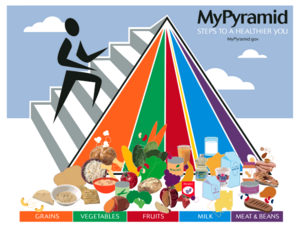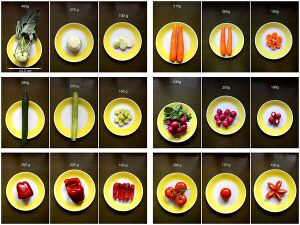Nutrition recommendations
Nutrition recommendations are based on the results of studies - these are general principles that reduce the risk of diseases of civilization. Nutritional recommendations for the adult population of the Czech Republic are generally referred to as healthy 13.
Healthy 13[edit | edit source]
1. Maintain an adequate constant body weight characterized by a BMI (18.5-25.0) kg / m 2 and waist circumference below 94 cm in men and below 80 cm in women.[1]
2. Exercise daily for at least 30 minutes, eg by brisk walking or exercising.[1]
3. Eat a varied diet, divided into 4-5 daily meals, do not miss breakfast.[1]
There are two reasons for this:
- the wider the range (more) of food consumed, the less likely it is that excessive or insufficient intake of individual nutrients will occur;
- concerns toxicology - some foods have a higher tendency to "live" the harmful substances with which they have come into contact. E.g. sea fish and animals accumulate heavy metals if they live in polluted waters (if I eat a reasonable amount of fish meat, it won't do me any good, but if I focus on the diet just worse), or if I eat too much soy, I eat too much phytoestrogens.
The variety of food is evaluated according to the pyramid, do not eat late in the evening, max. 3 hours before bedtime.
4. Consume a sufficient amount of vegetables (raw and cooked) and fruit, at least 500 g per day, divided into several portions; occasionally consume smaller amounts of nuts[1]
- Vegetables 2x more than fruit, because vegetables have on average 2x more minerals, trace elements and vitamins, but 2x less energy than fruit.
- Mainly protective effect - vegetables and fruits also contain substances not classified as nutrients - salicylates, carotenoids, lycopene have a protective effect…
5. Eat cereal products (dark bread and pastries, preferably wholemeal pasta, rice) or potatoes no more than 4 times a day, don't forget legumes.
- Legumes at least once a week - they contain proteins practically fat-free, in the sprouted state they also have vit. C..
6. Eat fish and fish products at least twice a week.[1]
- it is a source of unsaturated fatty acids and vit. A. _ Fatty sea fish contain significant amounts of vit. D , marine fish are also a source of iodine and fluorine . Small fish and bones are a source of calcium .
7. Include daily milk and milk products, especially sour milk; choose semi-fat and low-fat.
- Sour milk products are also tolerated by people with lactase deficiency . Products containing probiotics are preferred - some of the strains of lactic acid bacteria that have a beneficial effect on human health by improving their microbial intestinal balance.
8. Monitor fat intake, reduce the amount of fat both in hidden form[1] (fatty meat, fatty meat and dairy products, soft and long-lasting pastries with a higher fat content, chips, chocolate products), as well as bread and pastry spreads and food preparation. If possible, replace animal fats with vegetable oils and fats.
- Fats should make up no more than 30% of energy intake, ie a maximum of 70 g / day.
9. Reduce your sugar intake, especially in the form of sugary drinks (10 g / 100 ml), sweets, compotes and ice cream.[1]
- The only disease that has been shown to be associated with carbohydrates is caries; the addition of sugar to food increases its energy density (calories) without supplying other necessary nutrients at the same time.
10. Limit the intake of table salt and foods with a higher salt content (chips, salted sticks and nuts, salted sausages and cheeses), do not salt the ready meals.[1]
- The usual daily salt consumption is about 12 g, but only 5 g is recommended (3-5 g for hypertensives). 3 g of salt are already in food without salting; we should choose foods that are not oversalted and no longer salt.
11. Prevent food infections and poisoning by proper food handling, storage and food preparation; when cooking, prefer gentle methods, limit frying and grilling.[1]
12. Do not forget the drinking regime, drink at least 1.5 liters of fluids a day ( water , mineral water, weak tea, fruit teas and juices, preferably unsweetened).[1]
13. If you drink alcoholic beverages, do not exceed a daily alcohol intake of 20 g (200 ml of wine, 0.5 l of beer, 50 ml of spirits).[1]
Recommended daily intake of nutrients varies according to age, gender and physical activity. They are designed to cover the need for essential nutrients, selected vitamins, minerals and trace elements in almost all healthy people in a given population group. The actual need of an individual may vary. In the past, the recommended doses were focused mainly on the prevention of nutrient deficiencies (eg rickets, scurvy), today they are also aimed at reducing the risk of developing chronic non-infectious diseases (eg cardiovascular, some types of tumors).
- To prevent scurvy, 5-10 mg of vitamin C per day is enough. However, vitamin C also has antioxidant effects, so much higher doses are recommended, especially in some countries: the WHO recommends a daily dose of 45 mg / day, German-speaking countries (DACH 2000) recommend 100 mg.
In the Czech Republic, the recommended benefits from 1989, which are obsolete, are still formally valid (May 2011), therefore the recommended benefits of German-speaking countries, the so-called DACH 2000, are generally accepted. for recreation, referenced for the parent company, 1. Frankfurt am Main: Umschau / Braus, 2000).
Links[edit | edit source]
Related articles[edit | edit source]
- child nutrition: Newborn nutrition • Breastfeeding • Infant formulaInfant's non-diary diet • Toddler nutrition • Preschool, school and youth nutrition • Recommendations for infant nutrition 2011 • Recommended nutrient intake (pediatrics)
- Nutritional recommendation: Nutritional recommendations (1st Faculty of Medicine, Charles University, NT) • Nutritional recommendations for the adult population • Nutrition of pregnant and lactating women • Nutrition in old age • Factors influencing nutritional needs
- Special nutrition
- Food composition: Carbohydrates in food • fats in food • Minerals in food • Trace elements in food • Vitamins • Proteins • Microorganisms in food • Foreign substances in food
- Failure • Eating disorders • Nutrient excessive or deficient disease • Food allergies • Food intolerance • Cow's milk Protein allergies
- Socail food marketing
Reference[edit | edit source]
Použitá literatura[edit | edit source]



